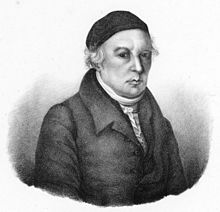Johann Anton André

Johann Anton André (October 6, 1775, Offenbach am Main – April 6, 1842, Offenbach am Main) was a German composer and music publisher.
André wrote operas, symphonies, masses, and lieder, as well as a still unfinished Lehrbuch der Tonsetzkunst (Textbook of the Art of Composition) in two volumes. In 1799, André purchased a large volume of Mozart's musical papers (the Mozart-Nachlass) from his widow Constanze, and brought them to Offenbach. This collection contained over 270 autographs and included the operas The Marriage of Figaro and The Magic Flute, a series of string quartets and string quintets, several piano concertos, and Eine kleine Nachtmusik. Based on these autographs, the André publishing house (founded in 1774 by André's father Johann André (1741–99) and still owned by the family today) prepared and issued some highly respected editions of Mozart's works, bringing many compositions into print for the first time. For his central contributions, André earned the title "father of Mozart research".
The success of the firm turned crucially upon a meeting in Munich in 1799 between André and Alois Senefelder, the inventor of lithography. Senefelder agreed to collaborate with André and granted his firm the right of using the new printing method for the first time, which took place in 1800 when the vocal score of André's own opera Die Weiber von Weinsberg came off the press. In 1839, André handed over the business to his son Johann August André (1817–87).
References
- Plath, Wolfgang. "André". Grove Music Online (subscription required). ed. L. Macy. Retrieved on March 17, 2007.
